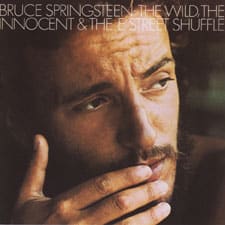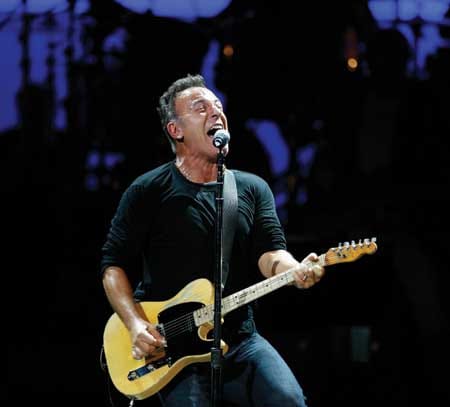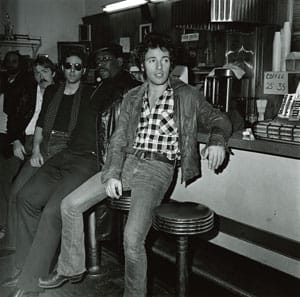The Wild the Innocent and the E Street Shuffle Album Art
By Rush Evans
It starts with a chaos of horns warming upwards, apace supported by the jangliest of guitars, and a musical sense of urgency building to what is perhaps the coolest opening line always sung: "Sparks fly on E Street when the male child prophets walk information technology handsome and hot. Teenage tramps in skintight pants wander the street, feel its heartbeat, and avoid the rut (cops) in a world all their i, as a girl chosen Little Angel elicits a full and gloriously sloppy chorus, 'Everybody class a line!'" Welcome to Bruce Springsteen'southward mystical, romantic, dangerous, wild, and innocent land of hope and dreams.

To a kid growing up in Jersey, stone and curlicue was all about escape, release, and finding joy in a dreary world. Just Chuck Berry and Elvis had simply taken the imagery so far. It took a bunch of hippies to take the art grade in its 2nd decade into trippier, weirder, more impressionistic territory, both lyrically and musically. Bruce Springsteen was a teenager in the '60s, the perfect age for the groovier "Sgt. Pepper" experimentations, merely he would favor that earlier stuff that rocked.
In Roy Orbison, he heard a sense of drama and depth in rock. It was the difference between fantasy and reality.
They say you have 20 years to make your commencement album and less than a twelvemonth to make your 2d. The sophomore slump has killed many a promising artist's career; the great ones get in to that third album and their own destiny.
In that location is no amend example of this than Bruce Springsteen. His get-go anthology had created a world of madman drummers, bummers, Indians in the summer and teenage diplomats, setting the stage for a vast body of piece of work unlike whatsoever other earlier or since. His third anthology would country him on the covers of Time and Newsweek, with a title track that captured all the aspirations of every young person dreaming of a meaningful life alee. "Born to Run" is nonetheless recognized, rightly so, as one of stone'south most successfully ambitious statements.
But it was that unsung second anthology, released but 8 months afterwards "Greetings from Asbury Park, New Jersey," that masterfully gave stone and roll its near cinematic experience. "The Wild, the Innocent and the E Street Shuffle" is to this mean solar day Springsteen'due south most overlooked album, but to those who know its 7 richly vivid songs, it is recognized as an innovative masterpiece.

Bruce Springsteen and his E Street Band bring the same intensity onstage now, as shown at this performance at New York's Carnegie Hall on May 13, 2010, every bit 40 years agone. (AP Photo/Jason DeCrow).
From the grapheme-driven rocker, "The E Street Shuffle," nosotros ease into the romantic beauty of "4th of July, Asbury Park (Sandy)," powered past accordion, audio-visual guitar and the vulnerably delicate vox of a tough guy in a tender moment, tired of hanging in them dusty arcades, banging them pleasure machines. "Kitty'due south Back" expands the bandage in a befouled-burning rocker that celebrates one irresistible bad-ass chick.
"Wild Baton's Circus Story," the best Tom Waits song Bruce ever wrote, sounds exactly like the traveling circus that moves in and out of the darkness on the edge of every town. Its migratory carnies and freaks are afforded respect past way of the most appropriate use of a tuba that stone music has ever known.
Side Two (for the vinyl lovers among u.s.) is a Gershwinesque suite of 3 lengthy songs, starting with "Incident on 57th Street," a New York City story brought to dramatic life, a total-length flick in eight minutes, unfolding with lyrics painting the characters and landscape while instruments ready the tone.

Photograph by Frank Stefanko
"Rosalita (Come Out Tonight)" is pure celebration of a defiant forbidden love, capturing its passionate feeling then effectively that it landed on Rock and Roll Hall of Fame'southward "500 Songs That Shaped Rock And Roll."
The climactic "New York City Serenade" takes stone and roll closer to both classical and jazz than whatever more aggressive rock opera ever has, doing so with strings and even more characters from the seedier underworld of urban life. If "Incident on 57th Street" was "West Side Story" in 8 minutes, this was "Midnight Cowboy" in 10.
Perhaps those trippy '60s records had, indeed, inspired what was his nigh aggressive and experimental product piece of work, but Bruce Springsteen's Jersey and New York remained spiritually far away from Pepperland.
Bruce never returned to such grand pieces, but that was only advisable to the story he was telling: Every bit life got tougher for his protagonists, so did their stories, their songs. He would continue bringing Sandy and Rosalita to life hundreds of times on stage, making those two girls the most enduring elements of this anthology. He would as well proper name his band later the album's opening track (ironically, it was this album's keyboardist, David Sancious, whose mother lived on the existent Eastward Street in Belmar, Northward.J., though Sancious would not become a true Eastward Street ring member).
With his side by side album, Bruce Springsteen would conquer the world, and he has been telling America's story with vision and humanity e'er since. Simply once upon a fourth dimension, that story was told through the wide-eyed perspective of a 23-year-erstwhile kid with a dream and an innate understanding of the hugeness of life'due south daily experiences, like the passion of young dearest, the celebration of relationships, the struggle for survival, and the fireworks on the fourth of July.
For related items in our Goldmine store:
- Get Greetings from E Street: The Story of Bruce Springsteen [With 2 Archival Posters and 30 Removable Facsimiles of Rare Memorabilia]
Source: https://www.goldminemag.com/features/true-5-star-albums-bruce-springsteen-the-wild-the-innocent-and-the-e-street-shuffle